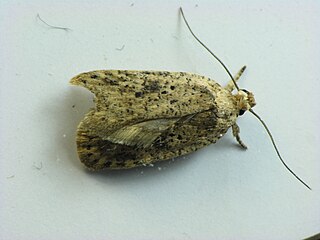| Depressaria cinereocostella | |
|---|---|
| Scientific classification | |
| Kingdom: | |
| Phylum: | |
| Class: | |
| Order: | |
| Family: | |
| Genus: | |
| Species: | D. cinereocostella |
| Binomial name | |
| Depressaria cinereocostella Clemens, 1864 | |
| Synonyms | |
| |
Depressaria cinereocostella is a moth in the family Depressariidae. It was described by James Brackenridge Clemens in 1864. [1] It is found in North America, where it has been recorded from Manitoba, Nova Scotia to Georgia and in Nebraska. [2]

Moths comprise a group of insects related to butterflies, belonging to the order Lepidoptera. Most lepidopterans are moths, and there are thought to be approximately 160,000 species of moth, many of which have yet to be described. Most species of moth are nocturnal, but there are also crepuscular and diurnal species.

Depressariidae is a family of moths. It has formerly been treated as a subfamily of Gelechiidae, but is now recognised as a separate family, comprising about 2300 species worldwide.

James Brackenridge Clemens was an American entomologist who specialized in Lepidoptera. He described many new species. His collection of microlepidoptera is in the Academy of Natural Sciences of Philadelphia.
The wingspan is 15–22 mm. The forewings are cinereous, overlaid with dull brownish red (except at the costa) and suffused with blackish fuscous in the basal half and irrorated (sprinkled) with black and cinereous scales. There is a series of longitudinal black dashes in the fold and along the veins and the base of the costa and anal angle are blackish fuscous. There is a series of ill-defined blackish-fuscous spots from the middle of the costa around the termen to the inner margin. The hindwings are greyish fuscous, but lighter basally. [3]

The wingspan of a bird or an airplane is the distance from one wingtip to the other wingtip. For example, the Boeing 777-200 has a wingspan of 60.93 metres, and a wandering albatross caught in 1965 had a wingspan of 3.63 metres, the official record for a living bird. The term wingspan, more technically extent, is also used for other winged animals such as pterosaurs, bats, insects, etc., and other fixed-wing aircraft such as ornithopters. In humans, the term wingspan also refers to the arm span, which is distance between the length from one end of an individual's arms to the other when raised parallel to the ground at shoulder height at a 90º angle. Former professional basketball player Manute Bol stands at 7 ft 7 in (2.31 m) and owns one of the largest wingspans at 8 ft 6 in (2.59 m).
The larvae feed on Oxypolis rigidior , Sium suave , Cicuta maculata , Carum carvi and Ligusticum scoticum . [4]

Oxypolis rigidior, also known as cowbane, pig-potato, or stiff cowbane, is a poisonous species of flowering plant in the celery, carrot, or parsley family native to eastern North America. Cowbane is a perennial wildflower found in wet habitats.

Sium suave is a perennial wildflower in the family Apiaceae. It is native to many areas of both Asia and North America. The common name water parsnip is due to its similarity to parsnip and its wetland habitat. The alternate common name hemlock waterparsnip is due to its similarity to spotted water hemlock.

Cicuta maculata is a species of flowering plant in the carrot family known by several common names, including spotted water hemlock, spotted parsley, spotted cowbane, and the suicide root by the Iroquois. It is native to nearly all of North America, from northern Canada to southern Mexico. It is a rhizomatous perennial herb producing a hollow erect stem to a maximum height between 1 and 1.5 metres. The long leaves are made up of several lance-shaped, pointed, serrated leaflets. Each shiny green leaflet is 2 to 10 centimetres long and the entire leaf may be up to 40 centimetres (16 in) long. The inflorescence of white flowers is similar in appearance to other species in the carrot family. It is a compound umbel with many clusters of flowers. The dry tan-brown fruit is a few millimeters long.